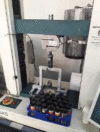Effects of Two Fluoride Mouthwashes on Surface Topography and Frictional Resistance of Orthodontic Wires
- PMID: 36458274
- PMCID: PMC9675628
- DOI: 10.18502/fid.v19i21.9968
Effects of Two Fluoride Mouthwashes on Surface Topography and Frictional Resistance of Orthodontic Wires
Abstract
Objectives: This study compared the effects of fluoride mouthwashes on surface topography of orthodontic wires, and static and kinetic frictional forces between the stainless steel (SS) orthodontic brackets and SS and nickel-titanium (NiTi) archwires. Materials and Methods: This in vitro, study evaluated 240 standard SS maxillary central incisor brackets and 0.018, and 0.025×0.019 inch NiTi and SS archwires. The wire-bracket sets (different combinations of wire diameters and types) were exposed to artificial saliva (control), 0.05% sodium fluoride (NaF) for 1 minute daily, or 0.2% NaF for 1 minute, weekly (37°C) for 3 months. The wires were pulled in bracket slots by 5 mm in a universal testing machine (10 mm/minute). The static and kinetic forces were measured. The surface topography of wires was inspected under a scanning electron microscope (SEM; x500). Data were analyzed by SPSS 25. Results: The mean static and kinetic frictional forces of 0.025×0.019 inch NiTi wire in 0.05% NaF group were significantly greater than SS wire (P=0.000). The mean kinetic frictional force in 0.05% NaF was significantly greater than 0.2% NaF and artificial saliva for all wires (P=0.001). The mean static and kinetic forces in 0.2% NaF were significantly greater than in artificial saliva (P=0.025). In all groups, larger wires showed higher mean frictional forces (P=0.000). SEM results revealed higher wire surface roughness in 0.05% NaF followed by 0.2% NaF group. Conclusion: Weekly use of 0.2% NaF mouthwash is recommended during sliding mechanics to minimize frictional forces between the SS and NiTi wires and SS brackets.
Keywords: Friction; Mouthwashes; Orthodontic Brackets; Sodium Fluoride.
Copyright © 2022 The Authors. Published by Tehran University of Medical Sciences.
Figures





Similar articles
-
Frictional resistances of different bracket-wire combinations.Aust Orthod J. 2004 May;20(1):25-30. Aust Orthod J. 2004. PMID: 15233584
-
Effect of fluoride on friction between bracket and wire.Dent Res J (Isfahan). 2011 Dec;8(Suppl 1):S37-42. Dent Res J (Isfahan). 2011. PMID: 23372594 Free PMC article.
-
Comparative Evaluation of Frictional Resistance Between Different Types of Ceramic Brackets and Stainless Steel Brackets With Teflon-Coated Stainless Steel and Stainless Steel Archwires: An In-Vitro Study.Cureus. 2022 Apr 15;14(4):e24161. doi: 10.7759/cureus.24161. eCollection 2022 Apr. Cureus. 2022. PMID: 35586355 Free PMC article.
-
Effect of chlorhexidine-containing prophylactic agent on the surface characterization and frictional resistance between orthodontic brackets and archwires: an in vitro study.Prog Orthod. 2013 Nov 20;14(1):48. doi: 10.1186/2196-1042-14-48. Prog Orthod. 2013. PMID: 24325758 Free PMC article.
-
In Vitro Comparative Evaluation of Frictional Resistance of Connecticut New Arch Wires, Stainless Steel and Titanium Molybdenum Alloy Archwires Against Different Brackets.Cureus. 2019 Nov 12;11(11):e6131. doi: 10.7759/cureus.6131. Cureus. 2019. PMID: 31886067 Free PMC article.
Cited by
-
Quantitative and qualitative analysis of metallic ion release of orthodontic brackets in three different pH conditions - An invitro study.J Oral Biol Craniofac Res. 2024 Jul-Aug;14(4):435-440. doi: 10.1016/j.jobcr.2024.05.001. Epub 2024 May 24. J Oral Biol Craniofac Res. 2024. PMID: 38832295 Free PMC article.
-
Clinical effect of chlorhexidine and sodium fluoride on corrosion behavior and surface topography of nitinol orthodontic archwires.BMC Oral Health. 2024 May 14;24(1):564. doi: 10.1186/s12903-024-04289-4. BMC Oral Health. 2024. PMID: 38745154 Free PMC article. Clinical Trial.
References
-
- Proffit WR, Fields HW, Henry W, Larson BE, Sarver DM. Contemporary Orthodontics. 6th ed. Philadelphia: Elsevier; 2019. pp. 528–9.
-
- Huffman DJ, Way DC. A clinical evaluation of tooth movement along arch wires of two different sizes. Am J Orthod. 1983 Jun;83(6):453–9. - PubMed
-
- Nanda R. Biomechanics in clinical orthodontics. 2nd ed. Philadelphia: WB Saunders; 2015. pp. 188–204.
LinkOut - more resources
Full Text Sources
